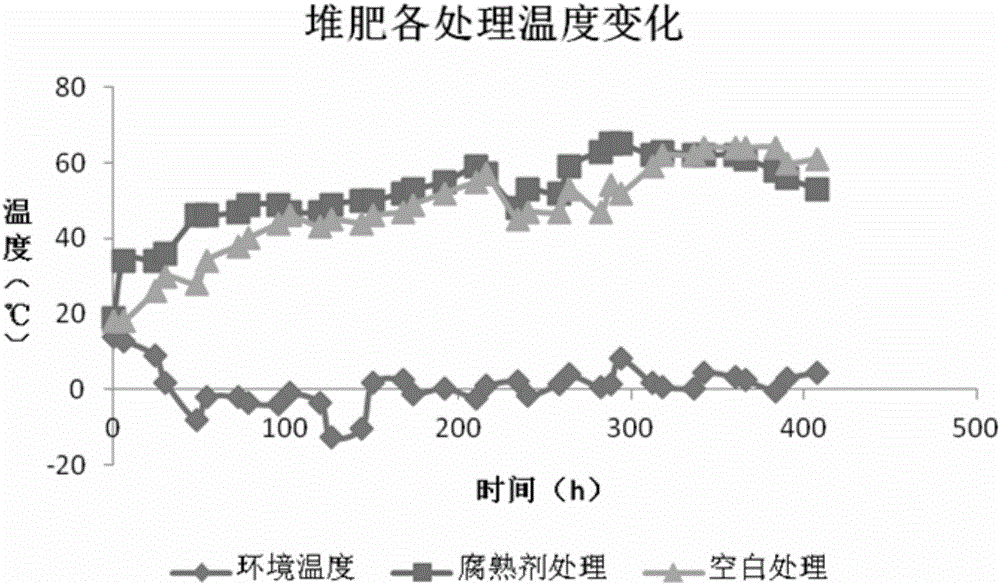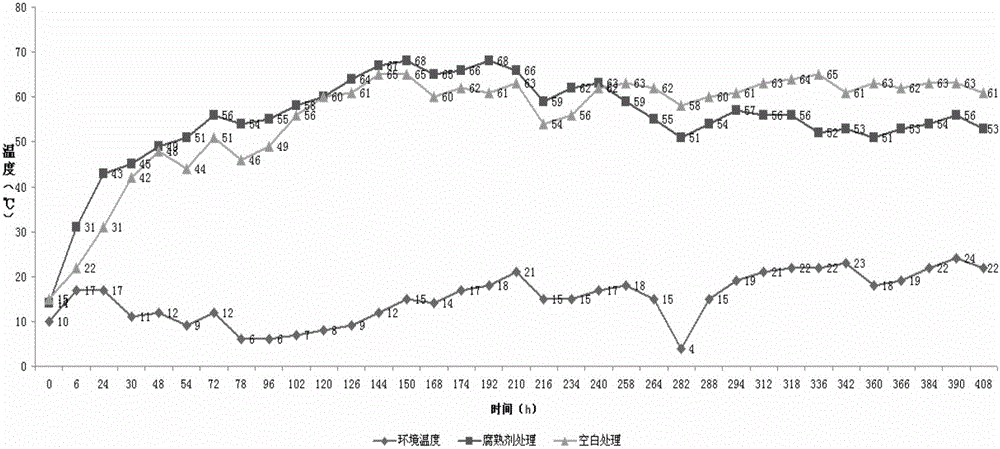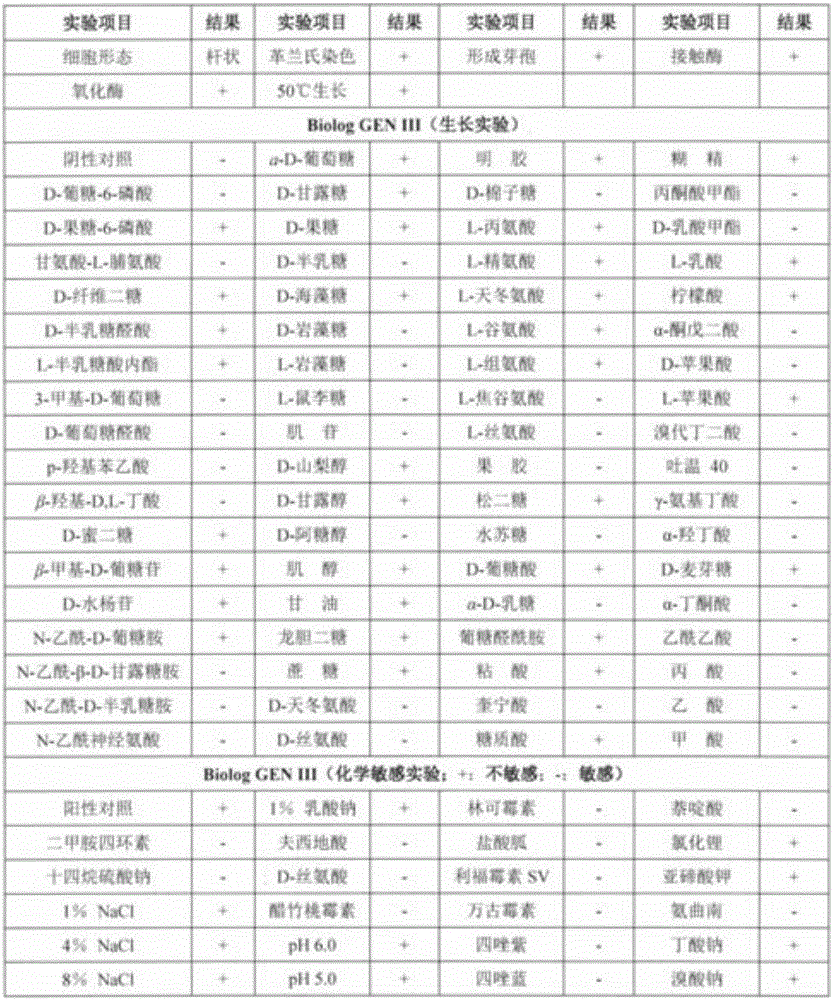Low-temperature-resistant composting fermentation microbial inoculum with deodorizing function and applications of low-temperature-resistant composting fermentation microbial inoculum
A bacterial agent and composting technology, which is applied in the field of compound microbial bacterial agents, can solve the problems of reducing the fertilizer efficiency of compost products, the number of effective microorganisms is small, and the compost fermentation temperature is difficult
- Summary
- Abstract
- Description
- Claims
- Application Information
AI Technical Summary
Problems solved by technology
Method used
Image
Examples
Embodiment 1
[0155] Embodiment 1, isolation and identification of bacterial strain
[0156] 1. Isolation and identification of strain W11025
[0157] 1. Isolation of strain W11025
[0158] Add 10.0g of the sample collected from the compost (in Wuyuan County, Inner Mongolia in October 2014) into 90mL sterile water with glass beads, let it stand for 20min, shake it fully on a rotary shaker at 200r / min for 30min, and obtain 1× 10 1 For the diluted bacterial suspension, use a sterile pipette to draw 5.0mL of the above bacterial suspension into a triangular flask filled with 45mL sterile water, shake well to obtain 1×10 2 Dilution of bacteria suspension, according to this method to make 1 × 10 3 , 1×10 4 , 1×10 5 diluted bacterial suspension.
[0159] Under sterile conditions, take 100 μL of the above dilutions of the bacterial suspension and spread it on the beef extract peptone medium, incubate at 20°C for 24-72 hours, observe whether there are colonies, and select a strain that grows f...
Embodiment 2
[0274] Embodiment 2, preparation and application of low temperature resistant composting starter
[0275] 1. Preparation of low temperature resistant composting starter
[0276] 1. Preparation of composite microbial agent
[0277] Take each microbial inoculum according to the following weight and mix to obtain the composite microbial inoculum: 1.4kg of Saccharomyces cerevisiae inoculum, 1.2kg of Candida maltosa inoculum, 1.0kg of Bacillus subtilis inoculum, and 1.4 kg of Bacillus amyloliquefaciens inoculum. kg, Aspergillus oryzae inoculum 1.5kg, Aspergillus niger inoculum 1.3kg, Bacillus stearothermophilus inoculum 1.0kg, Dispospora thermophilic inoculum 1.0kg.
[0278] The preparation method of the above-mentioned Saccharomyces cerevisiae inoculum is as follows: inoculate Saccharomyces cerevisiae W052502 strain (preservation number is CGMCC No.12701) in YPD medium, at 29 ° C, cultivated under the condition of 200rmp for 20 hours, then 3000r / m After being centrifuged and con...
Embodiment 3
[0300] Embodiment 3, preparation and application of low temperature resistant composting starter
[0301] 1. Preparation of low temperature resistant composting starter
[0302] 1. Preparation of composite microbial agent
[0303] Take each microbial inoculum according to the following weight and mix to obtain a composite microbial inoculum: 1.2 kg of Saccharomyces cerevisiae inoculum, 1.3 kg of Candida maltosa inoculum, 0.8 kg of Bacillus subtilis inoculum, and 1.4 kg of Bacillus amyloliquefaciens inoculum. kg, Aspergillus oryzae inoculum 1.5kg, Aspergillus niger inoculum 1.3kg, Bacillus stearothermophilus inoculum 0.8kg, Disposporum thermophilic inoculum 0.8kg. The effective viable counts of each bacterial agent before mixing are: Saccharomyces cerevisiae 5 billion cfu / g, Candida maltosa 5 billion cfu / g, Bacillus subtilis 30 billion cfu / g, Bacillus amyloliquefaciens 50 billion cfu / g, Aspergillus oryzae 2 billion cfu / g, Aspergillus niger 2 billion cfu / g, Bacillus stearothe...
PUM
 Login to View More
Login to View More Abstract
Description
Claims
Application Information
 Login to View More
Login to View More - R&D
- Intellectual Property
- Life Sciences
- Materials
- Tech Scout
- Unparalleled Data Quality
- Higher Quality Content
- 60% Fewer Hallucinations
Browse by: Latest US Patents, China's latest patents, Technical Efficacy Thesaurus, Application Domain, Technology Topic, Popular Technical Reports.
© 2025 PatSnap. All rights reserved.Legal|Privacy policy|Modern Slavery Act Transparency Statement|Sitemap|About US| Contact US: help@patsnap.com



